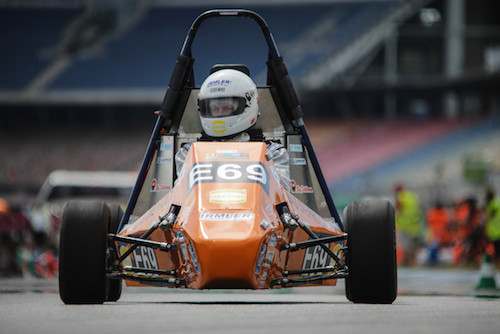Student Competitions: Prepping the Next Generation of Engineers

Competitions like Formula Student have resulted in cutting-edge automotive designs, particularly in the area of electric drive trains. Image Courtesy of MathWorks
Latest News
August 22, 2016
Who holds the record for the fastest acceleration on an electric vehicle? Hint: It’s not any of the automotive powerhouses in Detroit or Europe—it’s “Grimsel,” a car that goes 0-60mph in just 1.513 seconds and was created by a Formula Student design team.
From electric drive trains to inventive wheel designs and autonomous operation, many of the cutting-edge technologies under development by the automotive OEMs are also being pursued by student design teams. These global competitions not only advance the ball on cutting-edge concepts that sometimes make their way into commercial products, they also let student participants plunge head first into real design challenges in a way that traditional classroom learning can’t match.
 Competitions like Formula Student have resulted in cutting-edge automotive designs, particularly in the area of electric drive trains. Image Courtesy of MathWorks
Competitions like Formula Student have resulted in cutting-edge automotive designs, particularly in the area of electric drive trains. Image Courtesy of MathWorksJust ask Christoph Hahn, a multi-time participant in the European-based Formula Student motorsport competition. Backed by industry giants and high-profile engineers, the competition challenges student teams to design and build a single-seat racing car that can compete in static and dynamic events similar to Formula SAE held in the United States. Hahn, now an education technical specialist at MathWorks, says his experiences with the Formula student competition helped solidify many of the concepts he was taught in the classroom in a more compelling way than mastering theory.
“You get hands-on knowledge by applying all the stuff you learned in class and that gives you a better understanding of problems from a technical perspective,” he says. Beyond putting technical concepts into practice, the student competition experience taught him a lot about the softer skills required for engineering positions, including presentation savvy and project management.
Consider simulation and modeling—a critical skill set taught in class and instrumental for the design of today’s complex automotive products. While classroom instruction centers around the tools, mathematics and optimization theories surrounding simulation, refining an electric drive design design for a competition gives the student a chance to apply those theories. “You have to come up with information not yet available and try to create the scenario in a virtual world,” he explains. “This is bridging the gap between theory and math to a real engineering problem.”
No longer a student competitor, Hahn now supports automotive student competition teams through his work at MathWorks. His role is to provide access to MathWorks MATLAB and Simulink technical computing software and to leverage his core competencies in physical modeling, control design, rapid prototyping and automated code generation to help the student teams in their design efforts.
MathWorks supports its student teams in a variety of ways, including providing training materials for its tools along with a series of informational video podcasts delivered through the MATLAB and Simulink Racing Lounge.
Supporting student competitions in automotive and other industry sectors is also good for students, but it’s equally effective for industry. The automotive sector can draw from another source of innovation and ideation to solve increasingly complex and challenging design problems while software providers like MathWorks get their software in front of next-generation engineers.
“Even if some of the [student team designed] technology doesn’t survive and make it into cars on the road, it’s the knowledge students get that’s so important,” says Hahn. “After all, the students of six, seven, even eight years ago are the automotive engineers of today. They take the skill sets and knowledge they got from their student competition career and bring it to the automotive companies.”
Watch this video of highlights from the 2016 Formula Student competition.
Subscribe to our FREE magazine, FREE email newsletters or both!
Latest News
About the Author
Beth Stackpole is a contributing editor to Digital Engineering. Send e-mail about this article to [email protected].
Follow DE






